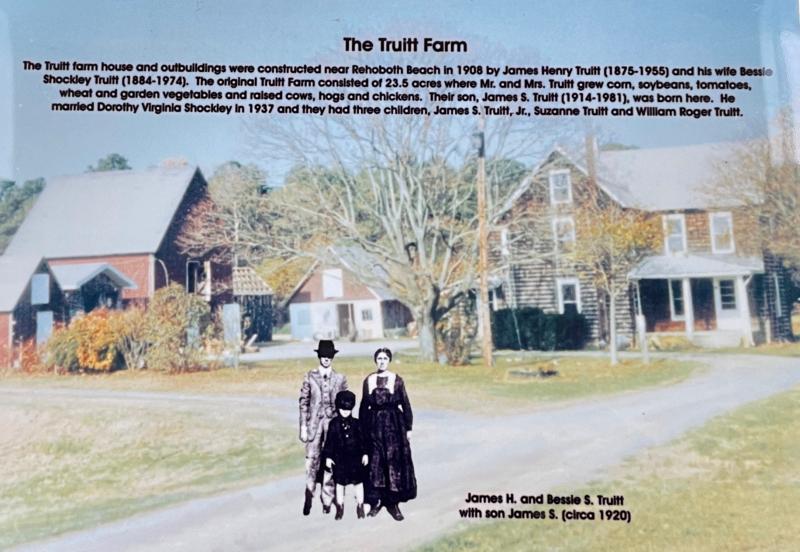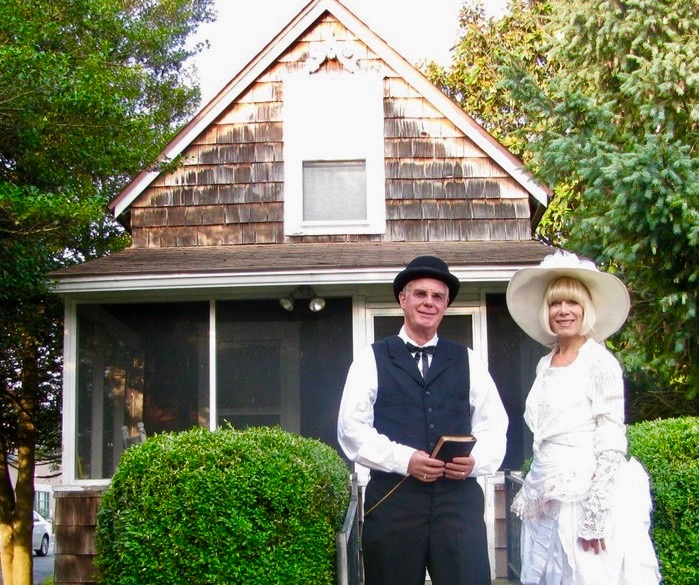Truitt family rooted in Rehoboth Beach history
The Truitt family has its roots tied to the history and growth of Rehoboth Beach.
George Truitt arrived in Accomack County, Va., on a ship from England in the early 1600s. In the 1760s, some of his descendants migrated to Delaware, including a line who settled in Fenwick Island and then moved to the Rehoboth Beach area.
While there are many Truitts living in Sussex County today, Roger Truitt, his brother James Jr. and sister Suzanne are among the few who were raised in Rehoboth, graduated from Rehoboth High School and continue to live in the Rehoboth area.
Roger, a semi-retired attorney, researched his family's genealogy and has spent countless hours studying the founding of Rehoboth Beach as a Methodist church camp meeting venue. In June, he self-published “Room Enough,” a novel about the founding of Rehoboth in 1873. The book also covers the next eight years when the “sinners won out over the saints,” as his novel explains.
Grandparents move to Rehoboth
Roger’s grandfather, James Henry Truitt, came to Rehoboth in 1908 and purchased a 23-acre farm located off Shuttle Road that is now known as Truitt Homestead. He married Bessie Shockley, and they grew field corn, and raised cows, pigs and chickens. Their only child, James S. “Jimmy” Truitt, was born in 1914, and he helped them grow and harvest vegetables such as corn, tomatoes, squash and cucumbers, which he hauled to Wilmington and Philadelphia.
A mule was used to plow the fields, and the farm didn’t get electricity until 1948. They had to milk seven cows a day, and the raw milk was taken to the former Rehoboth Dairy on Wilmington Avenue. After a week of hard work, Sundays were reserved for family time and outings, which sometimes included a trip to the Boardwalk where each grandchild was given a nickel to spend, Roger said.
Jimmy met his wife Dorothy on the Rehoboth Boardwalk in 1936. When they married a year later, they rented from Anna Hazzard one of the last tent houses in Rehoboth at the corner of Baltimore Avenue and Second Street. That same cottage became the Anna Hazzard Tent House Museum now located on Christian Street.
Tent houses, which were small wooden frame cottages, were built in the 1870s by members of the Rehoboth Beach Camp Meeting Association and also in the 1890s on Baltimore Avenue as part of a revival of the camp meetings. The City of Rehoboth moved the Anna Hazzard cottage to Christian Street in 1976, when it became Rehoboth's first history museum.
Truitt Homestead
While Jimmy was primarily a farmer, he also helped build roads at Dover Air Force Base and improve many of the streets in Rehoboth Beach in the 1940s. Then he established a general contracting business that included earth-moving equipment, dump trucks and a borrow pit near Midway. Sand from the borrow pit was used to help rebuild Rehoboth’s beach following the Storm of 1962.
Jimmy also invested in residential and commercial real estate by purchasing land from local farmers and at sheriff's sales. He and Dorothy developed and sold lots in many of the Rehoboth area’s first subdivisions, such as Scarborough Avenue Extended, Truitt Development, Tru-Vale Acres, Fieldwood and Sandy Brae.
“My parents grew up in the Depression era, and their vision and hard work truly represent an American success story,” Roger said.
Jimmy and Dorothy left their properties to their children with the understanding that the original 23-acre farm property would remain in the Truitt family. Initially the property was leased to tenant farmers. Then it became a driving range and par 3 golf course in the 1990s and early 2000s.
In 2015, Roger and his brother entered into a long-term lease agreement with local developers who built Truitt Homestead, an age-restricted community with 89 single-family homes and the Lodge at Truitt Homestead, a senior independent-living community with 85 units. Suzanne Truitt is a resident of the Lodge.
Rooms honor family
As part of the lease agreement, the Truitts were allowed to name four rooms in the Lodge in honor of their family and its history.
The Truitt Family Room pays tribute to the original Truitt Homestead and farm; it includes photos of Roger’s grandparents, parents and siblings.
The James S. “Jimmy” Truitt Game Room is named in honor of Roger’s father. He loved football, baseball and basketball, and he was recruited out of high school to play college baseball in Williamsport, Pa., but after one year, he had to return to the farm to help his parents.
The Shockley Dining Room is named in honor of Bessie Shockley Truitt, who married James H. Truitt and lived on the farm, and Dorothy Shockley Truitt, who married Jimmy Truitt. They share the same maiden name but were from different states. Bessie (1884-1974) grew up in the Milford area, and Dorothy (1919-2010) in Greensboro, Md. The two women were passionate cooks who were known locally for their pies and cakes.
Novel on Rehoboth
After researching the early history of Rehoboth, Roger began in 2014 to portray the Rev. Robert Todd, the founder of Rehoboth, in period costume. He has done living history reenactments for the Rehoboth Beach Historical Society, where he is a board member, at the Anna Hazzard tent house and other venues. Roger’s wife Patricia has played the part of Anna Hazzard, Delaware’s first female real estate broker, and she told the rest of the story of Rehoboth’s development.
The Rev. Todd established the Rehoboth Beach Camp Meeting Association of the Methodist Episcopal Church in 1873 for church members to visit the seaside for revivals during the summer. The association raised $10,000, purchased more than 400 acres of land, constructed a tabernacle and campground (behind what is now Egg Restaurant), and built a boardwalk and hotel in the 1870s.
When the railroad came to Rehoboth in 1878, it spelled doom for the association as development boomed and many more people arrived, most of whom were not interested in religious pursuits. As Rehoboth became a more secular tourist destination, the church closed the association’s camp meetings in 1881.
Patricia urged Roger to portray the Rev. Todd and to write a book about the founding of Rehoboth. “There are so many books about Rehoboth. I decided to take a different approach and write a historical novel about the founding and early development of Rehoboth,” he said. “I wanted my children and grandchildren, who love coming to Rehoboth, to learn about its early years.”
Roger said most of the characters in the book “Room Enough” are based on actual people and events, except for the protagonist Will Thompson, a devout atheist who is converted by the Rev. Todd. “It is through Will’s eyes that we see how the early religious settlers in Rehoboth confronted racial differences, homosexuality and businessmen who wanted to develop Rehoboth for profit,” Roger said.
He worked on the book off and on for seven years while continuing to pursue his career as an environmental lawyer. “Room Enough” is available at the Rehoboth Beach Museum, Browseabout Books and Amazon with proceeds benefiting the museum.
Roger hopes to write a sequel to “Room Enough” that covers the next 40 years or so of Rehoboth’s history. In the meantime, he enjoys working as an environmental consultant, playing golf at Kings Creek Country Club and boating on Rehoboth Bay with his three children and eight grandkids.
Roger is an active member of Epworth Methodist Church in Rehoboth, where he facilitates small-group Bible studies, chairs the cemetery committee and participates in prison ministry.
Baseball is a passion
Like his father, Roger has had a lifetime passion for baseball. When he lived and worked in Baltimore, he attended the first Orioles game at Camden Yards in 1992, and he has been to many more Orioles and Ravens games over his lifetime. He also participated in Orioles Dream Week in Sarasota, Fla., where he had a chance to meet Orioles players and coaches.
As a 10-year-old in 1961, he was on the first Rehoboth Little League team. After the first season (and a 23-0 loss to Georgetown in the playoffs), his father and other parents and supporters built a ballpark on the Forgotten Mile. That year, Rehoboth beat Georgetown 3-1 in the playoffs.
“It was a classic redemption story that the Rev. Todd would have enjoyed telling his parishioners at the Rehoboth Tabernacle,” Roger said with a smile.

























































